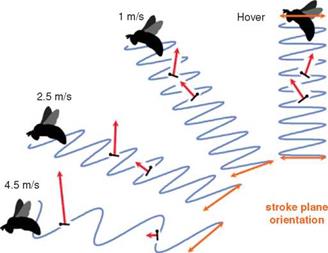Power Implication of Flapping Wings
One of the first researchers to explore the consequences of the trend in which larger animals oscillate their limbs at lower frequencies than smaller ones of a similar type was Hill [72]. He concluded that the mechanical power produced by a particular flight muscle is directly proportional to the contraction frequency. This conclusion has made flapping frequency an important parameter when trying to describe the theories behind flapping wings. Pennycuick [73] conducted one of the most thorough studies of the wing-beat frequency. He assumed that there is a natural frequency, imposed on the animal by physical characteristics of its limbs and by the forces they have to overcome. To be efficient, locomotion muscles have to be adapted to work at a particular frequency. For example, for walking animals, Alexander [74] showed that the first natural frequency is proportional to
![]()
 |
(1-21)
where g is the acceleration of gravity and Zleg the leg length. Similar approaches can be used for flight.
Pennycuick [73] identified several physical variables that affect the wing-beat frequency:
b: Wing span (m)
S: Wing area (m2)
I: Wing moment of inertia (kg m2) ~ m(b/2)2 p: Air density (kg/m3)
Allowing these variables to vary independently and assuming that the wing moment of inertia is proportional to m(b/2)2, Pennycuick [73] deduced the following correlation for the wing-beat frequency by incorporating data from 32 different species:
f = 1.08(m1/3g1/2b-1S,-1/4p1/3). (1-22)
In an updated study Pennycuick [59] added 15 species and made a more detailed analysis. This leads to the following expression:
f = m3/8g1/2b-23/24 S-1/3p3/8. (1-23)
Equation (1-21) can be used to predict the wing-beat frequency of species whose mass, wing span, and wing area are known. As mentioned earlier, the moment of inertia I for the wing is dependent on both the span b and the body mass m; hence, a change in any of these variables will result in a change in the moment of inertia. This effect may not be appropriate, given that a change in, for instance, body mass does not necessarily affect the number of the moment of inertia I. So, if we intend to predict these effects on the wing-beat frequency, it is more suitable to include I as an independent parameter [59]:
f = (mg)1/2 b-17/24S-1/31-1/8 p3/8. (1-24)
Another relation observed by Pennycuick et al. [75] is the effect of air speed on wing – beat frequency when body mass changes. The data for the wing-beat frequency and the air speed, U, are fitted with a least squares method:
f = k2 + k3/U + k4U3, (1-25)
where k2, k3, and k4 are proportional constants.











